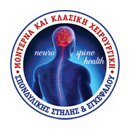Cervical discectomy is the indicated surgical treatment for a neck disc herniation. As with the lumbar microdiscectomy, it is performed with the assistance of a microscope by specialized spine surgeons. The access, that is the approach to the problematic area, depends on how fresh the herniation is as well as on the surgeon’s skills and training.
Posterior access
A lateral and fresh (“soft”) herniation, that is with no calcification or symphysis with the neighboring tissues, may be removed with posterior access. This method helps the patient to get rid of all the symptoms without affecting the spinal stability. Moreover, no foreign body is implanted in the patient and the patient can return to everyday activities in a short period of time.
Anterior access (ACDF)
The results of the anterior cervical discectomy are equally impressive. In this case, however, almost the entire herniated disc is removed and conditions of a likely cervical spine instability are caused. For this reason, after the discectomy, an implant in combination with bone implant is placed in order to keep the right width between the vertebral foramen and also to create fusion between the two neighboring vertebrae so there is no mobility between them. (see spinal fusion). To speed up this process, the neck movement limitation is required and this is assisted by a semi-hard collar that is removed after the first postoperative month. With the assistance of the collar, the patient can move right after the anesthesia effect stops.
The length of the incision on the nape is usually no more than 4cm. The horizontal orientation of the incision and its position within a natural skin fold make the incision almost invisible once the surgical wound is healed. The plastic surgery of the wound requires no external sutures and the patient is released immediately since not even the classic doctor’s appointment for removal of sutures on the eighth postoperative day is required.







